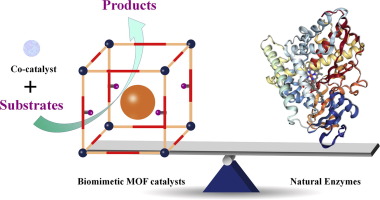Coordination Chemistry Reviews ( IF 20.3 ) Pub Date : 2018-02-13 , DOI: 10.1016/j.ccr.2018.01.016 Kai Chen , Chuan-De Wu

|
Enzymes are among the most sophisticated catalysts with unique features of high substrate affinity, unmatched catalytic efficiency and specificity. However, their practical applications are hindered by their high cost, the highly restricted catalytic conditions and their fragile nature. To solve these problems of enzymes for practical applications, biomimicry has therefore emerged as an effective approach to synthesize highly efficient biomimetic catalysts by imitating certain key features of enzymes. To tune the pore structures and modify the functional groups of metal–organic frameworks (MOFs), the porosity, functionality and hydrophobic/hydrophilic pore nature of the emerging porous materials are systematically tunable, which endow them to match certain enzymatic features, including structural features, active sites, microenvironments, assistant sites and/or catalytic properties of enzymes. Compared with their enzyme counterparts, biomimetic MOF catalysts present the advantages of broadened applicable conditions and enhanced stability, and sometimes they exhibit catalytic properties that are not possessed by the native enzymes. This review will selectively illustrate biomimetic MOF catalysts, consisting of immobilized biomimetic active sites on the pore surfaces or inside the pore space of porous MOFs. We will discuss the design principles and synthetic strategies for biomimetic MOF catalysts, and the relationships between their catalytic properties and structures. The key roles of active sites, microenvironment, transmission channels and co-catalytic sites, associated with the synergistic catalysis of biomimetic MOFs, will be addressed.
中文翻译:

用于催化应用的仿生金属-有机骨架的设计制造
酶是最复杂的催化剂之一,具有高底物亲和力,无与伦比的催化效率和特异性的独特特征。然而,它们的高成本,高度受限的催化条件和其易碎的性质阻碍了它们的实际应用。为了解决酶在实际应用中的这些问题,仿生因此成为通过模仿酶的某些关键特征来合成高效仿生催化剂的有效方法。为了调整孔结构并修改金属-有机骨架(MOF)的官能团,可以对新兴的多孔材料的孔隙率,功能性和疏水性/亲水性孔隙性质进行系统地调整,从而使其与某些酶促特征相匹配,包括结构特征,活动网站,微环境,辅助位点和/或酶的催化特性。与它们的酶对应物相比,仿生MOF催化剂具有可扩展的适用条件和更高的稳定性的优点,并且有时它们具有天然酶所不具备的催化性能。本文将有选择地说明仿生MOF催化剂,该催化剂由多孔MOF的孔表面或孔内固定的仿生活性位点组成。我们将讨论仿生MOF催化剂的设计原理和合成策略,以及它们的催化性能和结构之间的关系。将探讨与仿生MOF的协同催化相关的活性位点,微环境,传输通道和助催化位点的关键作用。











































 京公网安备 11010802027423号
京公网安备 11010802027423号